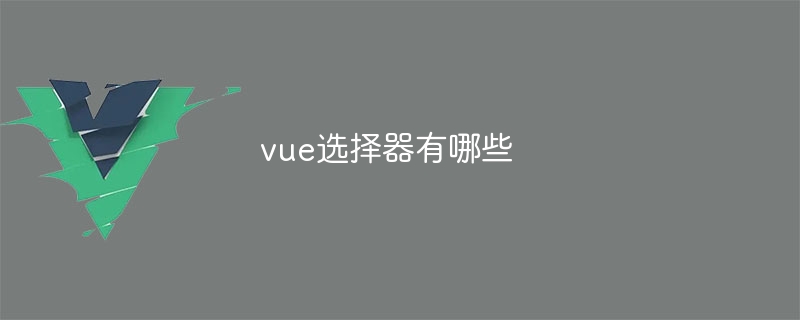
Vue selectors include class selectors, ID selectors, label selectors, attribute selectors, descendant selectors, child selectors and sibling selectors, etc. Detailed introduction: 1. Class selector, the class selector uses the CSS class name to select elements, you can use a period as a prefix, followed by the class name; 2. ID selector, the ID selector uses the unique ID of the HTML element to select For elements, you can use the pound sign as a prefix, followed by the ID value; 3. Tag selector, the tag selector uses the tag name of the HTML element to select the element, you can use the tag name directly, etc.

The operating system for this tutorial: Windows 10 system, DELL G3 computer.
Vue.js is a popular JavaScript framework for building user interfaces. In Vue.js, you can use a variety of selectors to select and manipulate DOM elements for interaction and dynamic updates. The following are commonly used selectors in Vue.js:
1. Class Selector: A class selector uses CSS class names to select elements. You can use a dot (.) as a prefix, followed by the class name. For example, select all elements with the class "my-class":
var elements = document.querySelectorAll('.my-class');
2. ID Selector (ID Selector): The ID selector uses the unique ID of the HTML element to select the element. You can use the pound sign (#) as a prefix, followed by the ID value. For example, select the element with the ID "my-id":
var element = document.querySelector('#my-id');
3. Tag Selector: The tag selector uses the tag name of the HTML element to select the element. You can use the tag name directly as a selector. For example, select all `
var elements = document.querySelectorAll('div');
4. Attribute Selector (Attribute Selector): The attribute selector uses the attributes of HTML elements to select elements. You can use square brackets ([]) to specify attribute names and attribute values. For example, select all elements with the "data-attr" attribute:
var elements = document.querySelectorAll('[data-attr]');
5. Descendant Selector: The descendant selector is used to select descendant elements of the specified element. You can use spaces to separate hierarchical relationships. For example, select `
` elements under all `
var elements = document.querySelectorAll('div p');
6. Child Selector: The child selector is used to select the direct child elements of the specified element. You can use the greater than sign (>) to represent subselectors. For example, select all direct child elements `
` of the `
var elements = document.querySelectorAll('div > p');
7. Sibling Selector: The sibling selector is used to select adjacent siblings of the specified element. element. You can use the plus sign ( ) to represent sibling selectors. For example, to select the `
` element immediately following the `
var element = document.querySelector('div + p');
It should be noted that the above selector example uses the native JavaScript selector method. Can be used in Vue.js. In addition, you can also use Vue-specific selectors in Vue.js, such as `v-bind` and `v-on` instructions to select and manipulate DOM elements.
To summarize, commonly used selectors in Vue.js include class selectors, ID selectors, tag selectors, attribute selectors, descendant selectors, child selectors and sibling selectors. These selectors can help developers select and operate DOM elements to achieve dynamic updates and interactive effects. According to different needs and scenarios, choosing the appropriate selector to operate DOM elements is one of the important skills in Vue.js development.
The above is the detailed content of What are the vue selectors?. For more information, please follow other related articles on the PHP Chinese website!